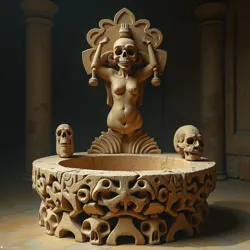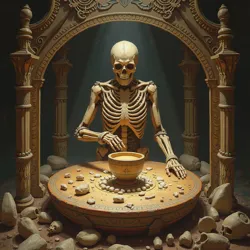Ritual of Osseous Communion
 A preserved ceremonial altar used in the Ritual of Osseous Communion, discovered in the Black Cenote District
A preserved ceremonial altar used in the Ritual of Osseous Communion, discovered in the Black Cenote DistrictThe Ritual of Osseous Communion represents one of the most enigmatic and profound spiritual practices of the Maqamiztleca people, combining elements of ancestor veneration with the region's unique psychoactive properties. This complex ceremonial tradition, still practiced in select areas of the Madlands of Tla'tlaqixi, involves the careful preparation and ritualistic consumption of specially treated bone matter believed to facilitate direct communication with ancestral spirits.
Historical Origins
The origins of the Osseous Communion can be traced back to the early settlement period of the Maqamiztleca in Tla'tlaqixi, approximately during the Great Migration Period. Ancient texts preserved in the Tla'tlaqixi Historical Archive suggest that the ritual emerged from the discovery that certain fungal species growing on ancestral remains, when combined with specific preparations of the Night-Blooming Consciousness Vine, produced unique visionary states that practitioners interpreted as direct contact with their forebears.
The practice gained particular significance during periods of cultural crisis, as it was believed to provide guidance from ancestral wisdom keepers. Archaeological evidence from the Sacred Groves of Eternal Dreaming indicates that specialized ceremonial chambers were constructed specifically for these rituals, with architectural features designed to enhance the psychoactive effects of the substances involved.
Ritual Components
The ceremony requires extensive preparation, typically lasting several lunar cycles. Central to the practice is the careful cultivation of the Ancestral Memory Fungus, a rare species that grows exclusively on properly prepared bone matter within specific geological formations found in the Madlands. This fungus forms a symbiotic relationship with mineral deposits in the bones, creating compounds that interact uniquely with human consciousness.
The ritual itself takes place during specific astronomical alignments, when the Council of Eternal Remembrance determines that the boundary between the material and spiritual realms is at its thinnest. Participants undergo lengthy purification rites, including exposure to carefully measured doses of Schzächt's Arrow-Frog secretions, which are believed to prepare the nervous system for the intense experiences to follow.
Ceremonial Process
 Traditional preparation of ancestral remains for the communion ritual, performed by authorized members of the Bone Speaker Society
Traditional preparation of ancestral remains for the communion ritual, performed by authorized members of the Bone Speaker SocietyThe actual communion occurs in three distinct phases, each corresponding to different levels of ancestral connection. The initial phase, known as the "Opening of the Marrow Gates," involves the careful consumption of specially prepared bone powder infused with extracts from the Ancestral Memory Fungus. This is followed by the "Descent of the Blood Memory," during which participants enter a deep trance state facilitated by the combined effects of various sacred plants.
The final and most significant phase, the "Union of Generations," typically lasts several days during which participants report experiencing not only communications with ancestral spirits but also physical sensations of temporarily inhabiting their ancestors' bodies. These experiences are carefully documented by trained observers who have developed immunity to the psychoactive effects through years of gradual exposure.
Modern Practice and Research
Contemporary practice of the Osseous Communion remains strictly regulated by indigenous authorities, particularly the Council of Indigenous Knowledge, who maintain that the ritual's power derives not only from its chemical components but from the maintenance of proper ceremonial protocols. Scientific interest in the practice has grown significantly, particularly following several documented cases of participants accurately relating historical information that was later verified through archaeological discoveries.
The Institute of Consciousness Studies has conducted limited research into the neurological effects of the ritual, though their work remains controversial within indigenous communities. Their findings suggest that the unique combination of substances involved may facilitate access to genetically encoded memories, though the mechanism for this remains poorly understood.
Conservation Challenges
The continuing practice of the Osseous Communion faces several challenges in the modern era. The Environmental Protection Coalition has expressed concern about the sustainable harvest of the rare fungal species required for the ritual, while indigenous leaders worry about the preservation of traditional knowledge regarding proper preparation techniques.
The delicate balance of environmental factors required for the growth of the Ancestral Memory Fungus has been disrupted in several traditional ceremonial sites, leading to efforts by the Mycelial Mapping Project to identify and protect remaining viable locations. These efforts have revealed complex relationships between fungal networks and ancient burial sites that continue to puzzle researchers.
Cultural Impact
The ritual has profoundly influenced the development of Xochitl-speech, as many of the "vision-words" in this unique communication system were reportedly first received during Osseous Communion ceremonies. The practice has also contributed to the preservation of historical knowledge, as participants often emerge from the ritual with detailed information about ancient practices and events.
See Also
- Sacred Burial Practices of Tla'tlaqixi
- Ancestral Memory Preservation
- Fungal Communication Networks
References
Documentation of the ritual's effects and procedures is maintained by the Festival of Dissolving Minds organizing committee, though access to the most sacred aspects of the practice remains restricted to initiated members of the tradition. The Department of Anomalous Biology continues to study the unique properties of the fungi involved, while respecting indigenous protocols regarding their sacred use.
Recent studies have focused on understanding the complex interaction between the ritual's various components, including the role of specific geological formations in the growth of the Ancestral Memory Fungus and the potential influence of underground mycelial networks on the ceremonial experience. These investigations continue to reveal new layers of sophistication in this ancient practice while raising questions about the nature of consciousness and ancestral memory.